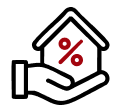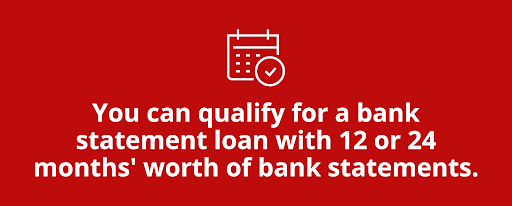What Is a Bank Statement? What It Is, Why It’s Important, & How to Get One
KEY TAKEAWAYS
- A bank statement is a monthly document that shows all transactions, deposits, withdrawals, fees, and account balances for a specific period, serving as a comprehensive record of your financial activity.
- Self-employed individuals, contractors, freelancers, and business owners can use 12-24 months of bank statements instead of traditional W-2s or tax returns to prove income for mortgage applications.
- Bank statements make the application process more accessible for non-traditional income earners while still maintaining responsible lending standards.



 Outstanding Client Experience
Outstanding Client Experience Specialized Lending Solutions
Specialized Lending Solutions Direct-to-Consumer Advantage
Direct-to-Consumer Advantage We're Advisors, NOT Salespeople
We're Advisors, NOT Salespeople Effortless Digital Mortgage Platform
Effortless Digital Mortgage PlatformUnderstanding your financial documents is crucial when applying for a home loan, especially if you’re self-employed or work as an independent contractor. What exactly is a bank statement, and how can it help you secure financing when traditional income verification methods don’t apply to your situation? This comprehensive guide explains everything you need to know about bank statements and how they can serve as proof of income for mortgage applications.

If you are a first-time home buyer, it’s important to explore all your options when trying to secure funding for your dream house. There are several types of home loans to consider. However, if you’re self-employed or have 1099 income due to working as a contractor, things become a bit more complicated. Without a W-2 showing the wages you earned from an employer, you might find it challenging to get a mortgage.
Fortunately, there are other ways to prove your income, including a bank statement loan. This article answers the question, “What is a bank account statement?” and discusses how you can obtain a bank statement to get a home loan.
Bank statement loans are ideal for prospective homeowners with no proof of income from an employer. Whether you’re a real estate investor, a freelancer, or a retiree, a bank statement loan can help you achieve your homeownership goals.
For self-employed borrowers and contractors with non-traditional income, using bank statement income verification through our streamlined digital portal means less paperwork and faster access to home financing.
KEY TAKEAWAYS
- A bank statement is a monthly document that shows all transactions, deposits, withdrawals, fees, and account balances for a specific period, serving as a comprehensive record of your financial activity.
- Self-employed individuals, contractors, freelancers, and business owners can use 12-24 months of bank statements instead of traditional W-2s or tax returns to prove income for mortgage applications.
- Bank statements make the application process more accessible for non-traditional income earners while still maintaining responsible lending standards.
What Is a Bank Statement?
So, what is considered a bank statement? If you have a bank account, you should get a bank statement every month. This document includes all transactions that occurred during the statement period. As well as containing your account information, it will show a detailed description of all deposits and withdrawals.
Your bank will issue these statements so that you can review your transactions. Typically, you’ll receive the statement on a specific day. All transactions appear in order by date.

Other information you might find on a bank statement includes the following:
- Statement period: This represents the dates covered in a bank statement. For example, your bank statement might run from January 15th to February 14th and come in the mail or to your email address at the end of February.
- Starting and ending account balances: By looking at your beginning and ending balances, you can calculate how much your balance increased or decreased based on your most recent spending.
- All completed transactions: Each line shows the date the transaction occurred, the amount of the transaction, and the name of the person or entity sending or receiving money from the account. You can also see pending transactions.
- Fees and any interest earned: If you have an interest-bearing account, it will show how much interest you earned.
- Bank information: The statement has the issuing bank, account number, and contact information, such as the phone number or mailing address.
Transaction level details typically include the amount involved, the payee, and the date. You can also see the same information for withdrawals, deposits, checks, and bank fees.
Bank Statement Example
A simplified bank statement might include a beginning balance of $1,000, one deposit for $3,000, and one withdrawal for $2,000. Assuming no service charges, you would have an ending balance of $2,000.
The bank statement should include the date and description for the withdrawal and deposit, as well as any other transactions that occur during the statement period.
How to Get a Bank Statement
Obtaining your bank statements is easier than ever—and you have multiple options to choose from, depending on your preference. Most banks and credit unions offer online access to your statements, where you can download a PDF copy for any month you need. If you cannot locate your statements online, you can contact your bank directly to request mailed copies or assistance accessing your account.
For borrowers applying for a bank statement loan, the fastest and most convenient method is using Griffin Funding’s secure digital portal. Our industry-leading bank-connection technology allows you to instantly and securely sync 12–24 months of bank statements from nearly all U.S. banks and credit unions with just one click, eliminating manual uploads and speeding up your mortgage process.
If you prefer traditional retrieval, you can still log into your bank’s online portal and download recent statements—typically covering the last 60 to 90 days—or opt for mailed paper statements. Regardless of the method you choose, it’s always a good idea to review your statements periodically to ensure accuracy and stay on top of your financial health.
What Is a Bank Statement Loan?
Bank statement loans provide a convenient alternative for self-employed borrowers and others who don’t have traditional jobs. They serve as an alternative for workers or business owners who don’t receive pay stubs or W-2s from employers. As such, bank statement loans are classified as Non-QM loans.
These non-traditional loans require additional documentation to prove your income and ability to pay your mortgage. We can assist self-employed borrowers with our bank statement loan program. Whether you’re looking for a bank statement purchase loan or a bank statement cash-out refinance loan, we have options that can help you achieve your financial goals.
Rest assured that self-employment does not necessarily disqualify you from getting a mortgage. You won’t have to submit tax returns to apply for a first-time mortgage loan. You can also use bank statement loans to apply for cash-out refinance loans on your current home.
If you are a realtor, restaurant, small business owner, or a member of the gig economy, this could be your best option for buying a new home or cashing out equity on the one you have.
Here are some of the most popular types of bank statement borrowers:
- Business owners
- Realtors
- Entrepreneurs
- Sole proprietors
- Retirees
- Freelance employees
- Contract workers
- Consultants
- Gig economy workers
- Independent contractors
If you’re a self-starter who likes to control your own destiny, one or more of these occupations may apply to you. Find out how a bank statement loan works and how you can use it to pursue your real estate investment goals.
Instead of collecting stacks of tax returns and pay stubs, borrowers can sync 12-24 months of statement data through our portal—accelerating approval and simplifying documentation.
How Does a Bank Statement Loan Work?
When you apply for a bank statement loan, you won’t need your tax returns, W-2s, pay stubs, or employment verification forms. As an alternative, you can use your checking and savings account bank statements to show cash flow and income trends.
However, you’ll still need to gather certain paperwork needed by your banker or the underwriter and have all requested documents ready before you get approved for a bank statement loan.

Here are some of the typical requirements for your bank statement loan application:
- 12 to 24 months of bank statements (business or personal)
- Be self-employed for at least two years
- Your business license, if applicable
- Proof of liquid assets for collateral
- A credit report showing a score of 620 or more
- Minimum 10% down payment
- Income is based on average monthly deposits
- A percentage of the deposits are counted based on your business type or a CPA letter
You may wonder why we need all this information. The truth is that the more information we have, the better case we can make for your mortgage loan request.
Benefits of a Bank Statement Loan
Although getting a loan at all may seem like a huge benefit if you’ve been denied traditional loans, there are other benefits of choosing a bank statement loan, including the following:

- No tax returns required: No need to bring tax returns or undergo a traditional income verification process.
- Streamlined income verification: Deposits to your bank account serve as direct proof of your monthly income, making the qualification process more straightforward for self-employed borrowers. This allows for greater income visibility — for people who take legitimate deductions.
- Simple documentation process: Business owners can easily obtain up to two years of bank statements, and if you prepare P&L statements, a certified public accountant will review your financials as required by the lender.
- Low down payment options: You can secure financing with as little as 10% down, making homeownership more accessible without requiring substantial upfront capital.
- High equity access for refinancing: Cash-out refinance loans allow you to borrow up to 80% of your home’s equity to fund new investment projects or business ventures.
- Substantial borrowing capacity: Bank statement loans offer financing up to $5 million using only your bank statements as income documentation.
- Flexible mortgage terms: Choose from various loan structures, including fixed-rate, adjustable-rate, or interest-only mortgages, to match your financial strategy and cash flow needs.
- Faster document turnaround: thanks to our secure digital bank statement syncing software, which integrates with a majority of US banks and credit unions.
Ready to explore your bank statement loan options? Contact us today.
Apply for a Bank Statement Loan Through Griffin Funding
A bank statement loan is a great alternative if your tax returns don’t reflect your true income. However, many self-employed workers may wonder if they’re eligible for other types of loans. We can help you work through the process and choose a loan that’s consistent with your borrowing needs and sources of income.
Bank statement loans have their downsides, but they are a great tool if you need a better way to show your revenue. At Griffin Funding, we offer bank statement loans and other types of asset-based loans to speed up the application process in your favor.
Get started online today or contact us to set up an appointment and discuss your real estate investment needs. By working with one of our loan specialists, you can find a home loan that best suits your goals.
Find the best loan for you. Reach out today!
Get StartedFrequently Asked Questions
What is the purpose of a bank statement? 
Why is it important to review bank statements? 
What is a combined banking statement? 
Recent Posts
Net Operating Income: Definition, Formula, & Examples
What Is Net Operating Income (NOI)? Net operating income measures how much money your investment property gene...
Best DSCR Lenders: Griffin Funding vs Angel Oak vs Kiavi vs Visio vs Lima One vs Easy Street
What to Look for in a DSCR Lender Choosing the best DSCR lender for your unique situation means evaluating sev...
Cash on Cash Return in Real Estate: Definition, Formula, & Examples
What Is Cash on Cash Return? Cash on cash return (CoC) is a metric that measures the annual income you generat...









